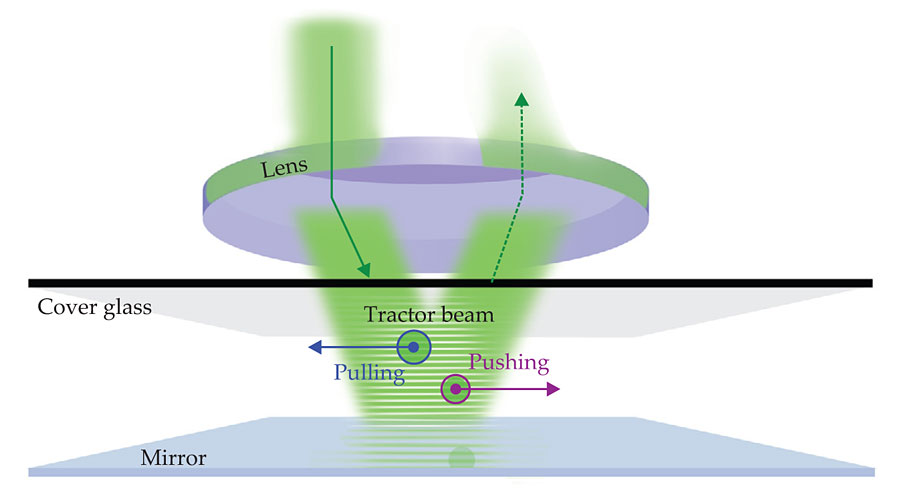An optical tractor beam sorts microscopic particles
DOI: 10.1063/PT.3.1938
Light typically pushes particles forward thanks to radiation pressure. But it can also pull them backward. A gradient in laser intensity, for instance, can produce optical forces large enough to move the particles—either upstream or down—toward a beam’s focus, where they remain trapped, a phenomenon known as optical tweezing (see Physics Today, December 1997, page 17
Marston presented his theory in the context of acoustic waves, 1 but it applies equally to photons. 2 , 3 His trick was to use a Bessel beam, which has the unusual property of not dispersing as it propagates. It’s essentially the superposition of plane waves whose wavevectors are canted at an angle with respect to the propagation axis and form a cone along it. If that angle is steep enough, once such a beam encounters an object, more of the photons can be scattered forward than backward. By conservation of momentum, the object has no choice but to recoil backward.
But even slight changes in the object’s size, shape, surface roughness, or refractive index can alter the photon scattering direction. Exploiting that sensitivity, Pavel Zemánek from the Institute of Scientific Instruments of the Academy of Sciences of the Czech Republic, Tomáš Čižmár of the University of Saint Andrews in the UK, and their colleagues have now designed an elegant scheme that uses a tractor beam to separate different types of particles in a mixture. 4
Key to the achievement was their realizing that two plane waves, steeply angled toward each other and symmetric along the propagation axis, mimic a Bessel beam well enough to be used in the way Marston envisioned, at least over the range where the beams overlap. Illustrated in the figure, the team’s experimental geometry could hardly be simpler. A single, relatively wide Gaussian laser beam is reflected from the mirrored bottom of an aqueous cell containing two sizes of polymer spheres. Interference of the incident and reflected waves forms fringes that determine the spheres’ net deflection—either to the right or left.

A laser beam (green) reflected from the mirrored bottom of an aqueous cell interferes with itself and forms interference fringes (white). If the angle between incident and reflected beams is sufficiently wide, nearly antiparallel, those fringes can produce enough forward scattering (to the right) that microscopic particles start to recoil to the left, against the momentum direction of the light field. Because the scattering is sensitive to particle size and beam polarization, it’s possible to create conditions whereby differently sized particles move in opposite directions. (Adapted from ref.

From their calculations, the researchers also realized that changing the beam polarization—with the electric field pointed either parallel or perpendicular to the plane of incidence—changes the scattering pattern enough that it can be used as a knob to reverse, on demand, the sign of the recoil force on certain sized spheres and thus their motion. Indeed, although the difference in optical force is slight, on the scale of piconewtons, only a perpendicularly polarized beam produced a pulling effect in the group’s liquid-cell experiments. In one example, tens of spheres of 800-nm and 1000-nm diameters were sorted in a light beam within two seconds of the researchers’ switching the beam’s polarization to the perpendicular orientation—one size pulled and the other pushed along the fringes.
Optical sorting isn’t the only possible result. Light scattering can also mediate particle interactions. The light scattered by one particle interferes with the light scattered by another and prompts either repulsion or attraction between them. An assembly of like particles may thus migrate to antinodes in the interference pattern and, although relatively far apart, become self-organized, or optically bound to each other in the light field.
Although the new scheme exerts tractor-beam-like forces, don’t expect it to reel in moon dust, let alone spacecraft. Indeed, mesoscopic particles can only be pulled over a distance—to date, about 30 µm—equal to the width of the enveloping beam. That width, however, is limited only by the available laser power.
Zemánek imagines that the group’s method will prove useful in compact lab-on-a-chip settings. New York University’s David Grier speculates that the range of applications may turn out to be wide. “Tractor beams, optical sorting, and optical binding are now all their own distinct subfields. The new scheme unites them in a single experiment—it’s a potpourri of classical optical manipulation techniques.”
References
1. P. L. Marston, J. Acoust. Soc. Am. 120, 3518 (2006). https://doi.org/10.1121/1.2361185
2. J. Chen et al., Nat. Photonics 5, 531 (2011); https://doi.org/10.1038/nphoton.2011.153
L. Zhang, P. L. Marston, Phys. Rev. E 84, 035601 (2011). https://doi.org/10.1103/PhysRevE.84.0356013. For a review of optically induced pulling forces, see A. Dogariu, S. Sukhov, J. Sáenz, Nat. Photonics 7, 24 (2012). https://doi.org/10.1038/nphoton.2012.315
4. O. Brzobohatý et al., Nat. Photonics 7, 123 (2013).https://doi.org/10.1038/nphoton.2012.332
